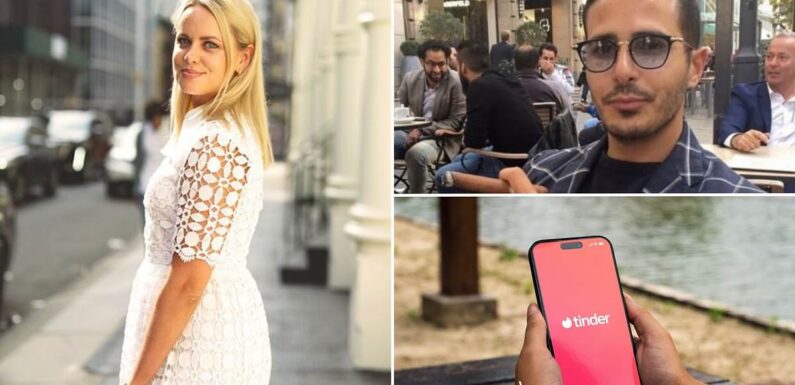
I was catfished by the Tinder Swindler – and these are the red flags to look out for to avoid falling victim of a romance scam
- Research reveals that 22% of Britons have fallen victim to catfishing in lifetime
- Cecilie Fjellhoy, a victim of the ‘Tinder Swindler’, reveals the red flags to look for
The saying goes that if it sounds too good to be true, it probably is – and that’s certainly the case when it comes to online dating.
Research by ExpressVPN has revealed that a staggering 22 per cent of Britons have fallen victim to catfishing in their lifetime.
While catfishing can occur on almost any online platform, Tinder remains one of the key apps where perpetrators prey on unsuspecting victims.
One person who knows all too well how easy it is to get tricked on the dating app is Cecilie Fjellhoy, who was famously duped by the ‘Tinder Swindler’.
Now, Ms Fjellhoy has spoken to MailOnline about her experience, in the hopes of stopping anyone else from being conned.
One person who knows all too well how easy it is to get tricked on the dating app is Cecilie Fjellhoy, who was famously duped by the ‘Tinder Swindler’
Ms Fjellhoy, 34, is a user experience designer from Norway, and was one of many women who was fooled into thinking Shimon Heyada Hayut (pictured), from Israel, was the son of a billionaire diamond merchant after meeting him on Tinder
READ MORE: The Tinder Swindler leaves viewers hooked
Ms Fjellhoy, 34, is a user experience designer from Norway, and was one of many women who was fooled into thinking Shimon Heyada Hayut, from Israel, was the son of a billionaire diamond merchant after meeting him on Tinder.
The convicted conman would use the money he acquired from other victims to impress single women with an expensive lifestyle and lavish gifts.
Incredibly, it’s believed he conned women out of around £7.4 million in total.
Speaking to MailOnline, Ms Fjellhoy said: ‘As far as my experience goes – we met on Tinder and frankly fell in love.
‘Lovely dates, and hundreds of amazing messages and videos.
‘We met up several times in person, as he was traveling around the world as the CEO of a big diamond company.’
Ms Fjellhoy says that there were early warning signs his business wasn’t the most secure.
‘After a while he told me he was in danger from threats from his competitors and could be hurt if he used any of his own credit cards,’ she explained.
‘As a result, he asked if he could use my cards, and also wanted me to take out loans to fill these up.
‘He promised he’d pay me back as soon as it was safe.
Ms Fjellhoy has spoken to MailOnline about her experience, in the hopes of stopping anyone else from being conned
While catfishing can occur on almost any online platform, Tinder remains one of the key apps where perpetrators prey on unsuspecting victims
READ MORE: Why Tinder can make it HARDER to find love: Excessive swiping creates anxiety and ‘partner choice overload’
‘He was a multimillionaire, after all, so I trusted him.
‘But in the end, I was swindled out of close to $200,000 – it left me feeling humiliated, ashamed and regretful.’
While you might think that Ms Fjellhoy’s case sounds unique, a survey of 2,000 Britons by ExpressVPN revealed just how rife catfishing really is.
Twenty-two per cent of respondents said they’d fallen victim to catfishing in their lifetime – a quarter of who had spoken to their perpetrator for more than a year before realising they were a catfish.
What’s more, 12 per cent of victims said they had been scammed out of money or gifts.
‘The positive is that since I have spoken out about my story on The Tinder Swindler, so many people – both men and women – have come forward with similar stories,’ Ms Fjellhoy said.
‘It’s quite shocking to see how often this is happening.’
Ms Fjellhoy has now revealed the red flags to look out for to avoid falling victim to a romance scam.
‘Firstly, if someone sounds too good to be true, then it is highly likely that they don’t really exist,’ she said.
‘We all have imperfections in one form or another – there really is no such thing as the “perfect profile”.’
On a more practical level, Ms Fjellhoy recommends doing a reverse image search on the photos of anyone you think might be a catfish.
‘This is an easy way to see if the photos of the person you are talking to are actually of someone else,’ she added.
Finally, Ms Fjellhoy says she’d used a VPN to add an extra layer of protection.
‘[A VPN] ensures your IP address is masked at all times – protecting your location and privacy and ensuring you can stay safe online,’ she said.
HOW CAN YOU CHECK IF YOU ARE BEING CATFISHED?
Dating apps and online websites are plagued with fraudulent profiles, known as ‘catfishes’.
‘Catfishing’ originated as a term for the process of luring people into false relationships, however, it has also come to encompass people giving out false information about themselves more generally.
These profiles often use images of another person to allow users to pretend to be someone else in order to get a date, or scam money from a lonelyheart.
Fortunately, there are certain ways to check if these profiles are real people or if they are bogus accounts —
1. Google reverse image search
This is probably the most valuable tool for catching out a catfish and can be done via Google.
To kickstart the process, people need only right-click the photos that are arousing their suspcions, copy the URL and paste it into images.google.com.
The search engine will search to see if the image has been used elsewhere.
If you find the picture associated with a different person to the one you’re speaking to on your dating app, it’s likely you’ve met a catfish!
2. Use an app called Veracity
It is useful for dating sites such as Tinder, Bumble and Grindr as it allows images from Dropbox or Camera roll (or similar) to be cross-referenced against any matching results.
Load the app, then select a screenshot of the suspicious dating app profile from your camera roll to launch the search.
The app will tell you if the picture belongs to somebody else.
3. Check their Facebook
Almost everyone who has a profile on a dating site will have a Facebook account (most dating apps require users to have one, after all!) so it is always advisable to track down your potential suitor on other forms of social media.
4. Google them
Google and other search engines have an extensive repertoire and most people will crop up in a search.
In this day and age, it’s unusual for someone to have nothing on Google.
Have a search through for them or their relatives, things they’ve said or posted in the past. If there’s nothing, that should raise alarm bells.
5. Skype/Facetime/Video Chat
For prospective romantic engagements, seeing the face of someone you are virtually talking to is essential.
6. Money
Anyone that asks for money online or via an app is likely to be a fraud.
This is probably a scam and should provide immediate red flags.
Source: Read Full Article




